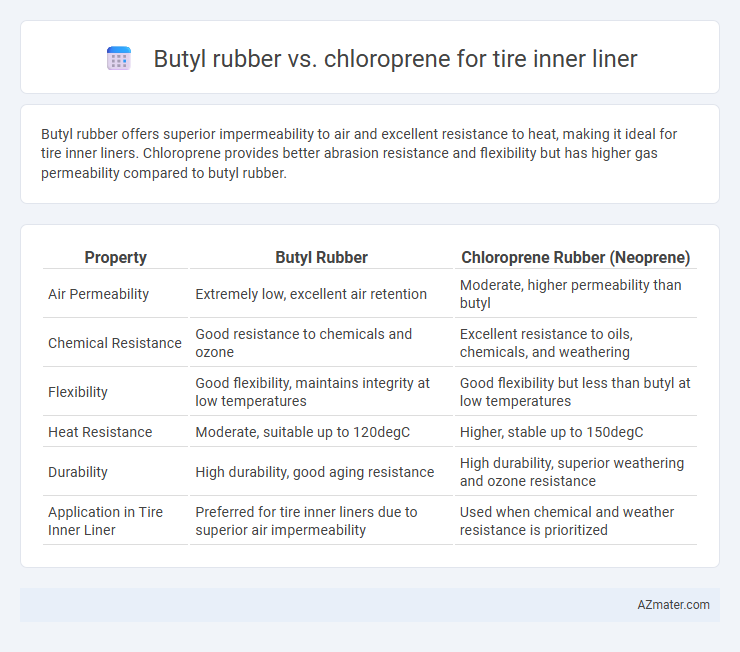Butyl rubber offers superior impermeability to air and excellent resistance to heat, making it ideal for tire inner liners. Chloroprene provides better abrasion resistance and flexibility but has higher gas permeability compared to butyl rubber.
Table of Comparison
| Property | Butyl Rubber | Chloroprene Rubber (Neoprene) |
|---|---|---|
| Air Permeability | Extremely low, excellent air retention | Moderate, higher permeability than butyl |
| Chemical Resistance | Good resistance to chemicals and ozone | Excellent resistance to oils, chemicals, and weathering |
| Flexibility | Good flexibility, maintains integrity at low temperatures | Good flexibility but less than butyl at low temperatures |
| Heat Resistance | Moderate, suitable up to 120degC | Higher, stable up to 150degC |
| Durability | High durability, good aging resistance | High durability, superior weathering and ozone resistance |
| Application in Tire Inner Liner | Preferred for tire inner liners due to superior air impermeability | Used when chemical and weather resistance is prioritized |
Introduction to Tire Inner Liners
Tire inner liners require materials with excellent impermeability to air and resistance to heat and chemicals, making butyl rubber and chloroprene key choices. Butyl rubber offers superior air retention due to its low permeability to gases, enhancing tire durability and reducing pressure loss. Chloroprene provides strong resistance to oils and weathering, supporting tire integrity in harsh environments while maintaining flexibility under varying temperatures.
Overview of Butyl Rubber
Butyl rubber is a synthetic elastomer known for its excellent impermeability to gases, making it the preferred choice for tire inner liners to ensure air retention and tire pressure stability. Its unique molecular structure, consisting of isobutylene with a small amount of isoprene, provides exceptional resistance to heat, ozone, and aging compared to chloroprene rubber. Butyl rubber's superior airtightness and chemical inertness enhance tire durability and safety, giving it a distinct advantage over chloroprene in inner liner applications.
Overview of Chloroprene Rubber
Chloroprene rubber, also known as polychloroprene or Neoprene, offers excellent resistance to weathering, ozone, and oil, making it a durable choice for tire inner liners. Its inherent flexibility and strong adhesion properties enhance the tire's overall performance and lifespan under varying environmental conditions. Compared to butyl rubber, chloroprene exhibits superior tensile strength and abrasion resistance, contributing to improved safety and durability in demanding driving environments.
Key Properties Comparison: Butyl Rubber vs Chloroprene
Butyl rubber exhibits superior air impermeability and excellent resistance to heat and ozone, making it ideal for tire inner liners that require long-term airtightness. Chloroprene offers enhanced oil, chemical, and abrasion resistance, contributing to durability under harsh operational conditions but has higher gas permeability than butyl rubber. Both materials deliver robust elasticity and aging stability, yet butyl rubber remains the preferred choice for maintaining consistent tire pressure over time.
Air Retention Performance
Butyl rubber exhibits superior air retention performance compared to chloroprene rubber, making it the preferred choice for tire inner liners where minimizing air permeability is critical. The low gas permeability of butyl rubber significantly reduces air loss, enhancing tire pressure maintenance and extending tire life. In contrast, chloroprene rubber's higher air permeability results in more frequent pressure loss, which can compromise tire safety and efficiency over time.
Chemical Resistance and Environmental Durability
Butyl rubber offers superior chemical resistance compared to chloroprene, effectively withstanding exposure to fuels, oils, and various solvents commonly encountered in tire inner liners. Its low permeability to gases ensures enhanced environmental durability, preventing air and moisture ingress that can degrade tire performance over time. Chloroprene, while resilient and flexible, generally exhibits lower chemical resistance and higher ozone degradation rates, making butyl rubber the preferred choice for inner liners requiring long-term stability in harsh chemical and environmental conditions.
Flexibility and Elasticity Under Pressure
Butyl rubber exhibits superior flexibility and elasticity under pressure, making it highly effective for tire inner liners by maintaining airtightness and resisting deformation during tire expansion and contraction. Chloroprene rubber offers good elasticity but tends to be less flexible under prolonged pressure, which may result in reduced durability and increased permeability. The enhanced pressure resilience and consistent elastic recovery of butyl rubber optimize tire performance and longevity compared to chloroprene.
Cost Analysis and Availability
Butyl rubber offers superior air impermeability and lower cost compared to chloroprene, making it a cost-effective choice for tire inner liners. Chloroprene, although more expensive due to complex manufacturing and raw material sourcing, provides better abrasion resistance and heat stability. Availability of butyl rubber is generally higher worldwide, supported by extensive production infrastructure, while chloroprene supply can be more limited and subject to fluctuations in chloroprene monomer prices.
Usage in Automotive Tire Industry
Butyl rubber offers superior air impermeability and excellent chemical resistance, making it the preferred material for tire inner liners in the automotive industry to maintain tire inflation and durability. Chloroprene rubber, also known as Neoprene, provides good abrasion resistance and weathering properties but falls short in gas impermeability compared to butyl rubber. These material properties influence the choice in tire inner liners, with butyl rubber dominating the market due to its enhanced air retention crucial for automotive tire performance.
Conclusion: Best Choice for Tire Inner Liners
Butyl rubber is the best choice for tire inner liners due to its superior air impermeability and excellent resistance to heat, chemicals, and aging, ensuring longer tire life and optimized performance. Chloroprene offers good flexibility and abrasion resistance but falls short in maintaining airtightness compared to butyl rubber. The enhanced durability and low gas permeability of butyl rubber make it the preferred material for maintaining tire pressure and safety.

Infographic: Butyl rubber vs Chloroprene for Tire inner liner
 azmater.com
azmater.com